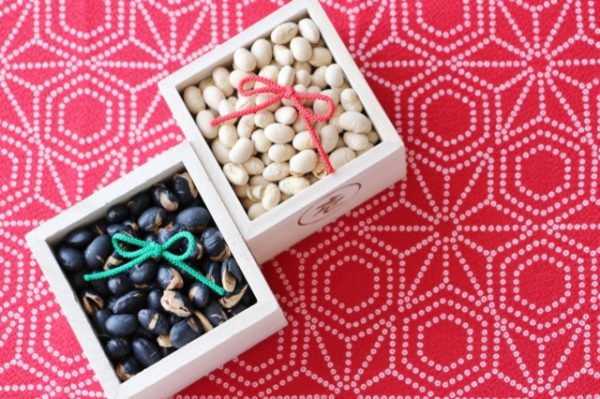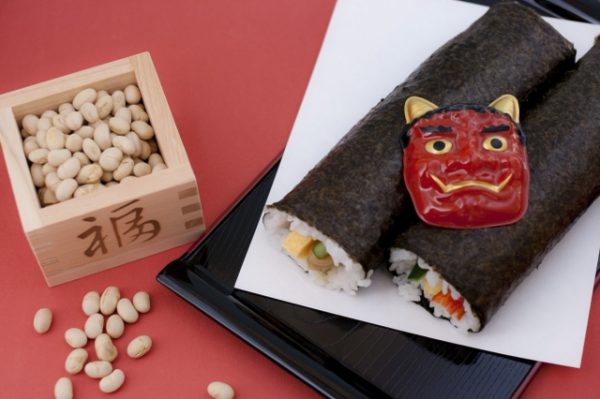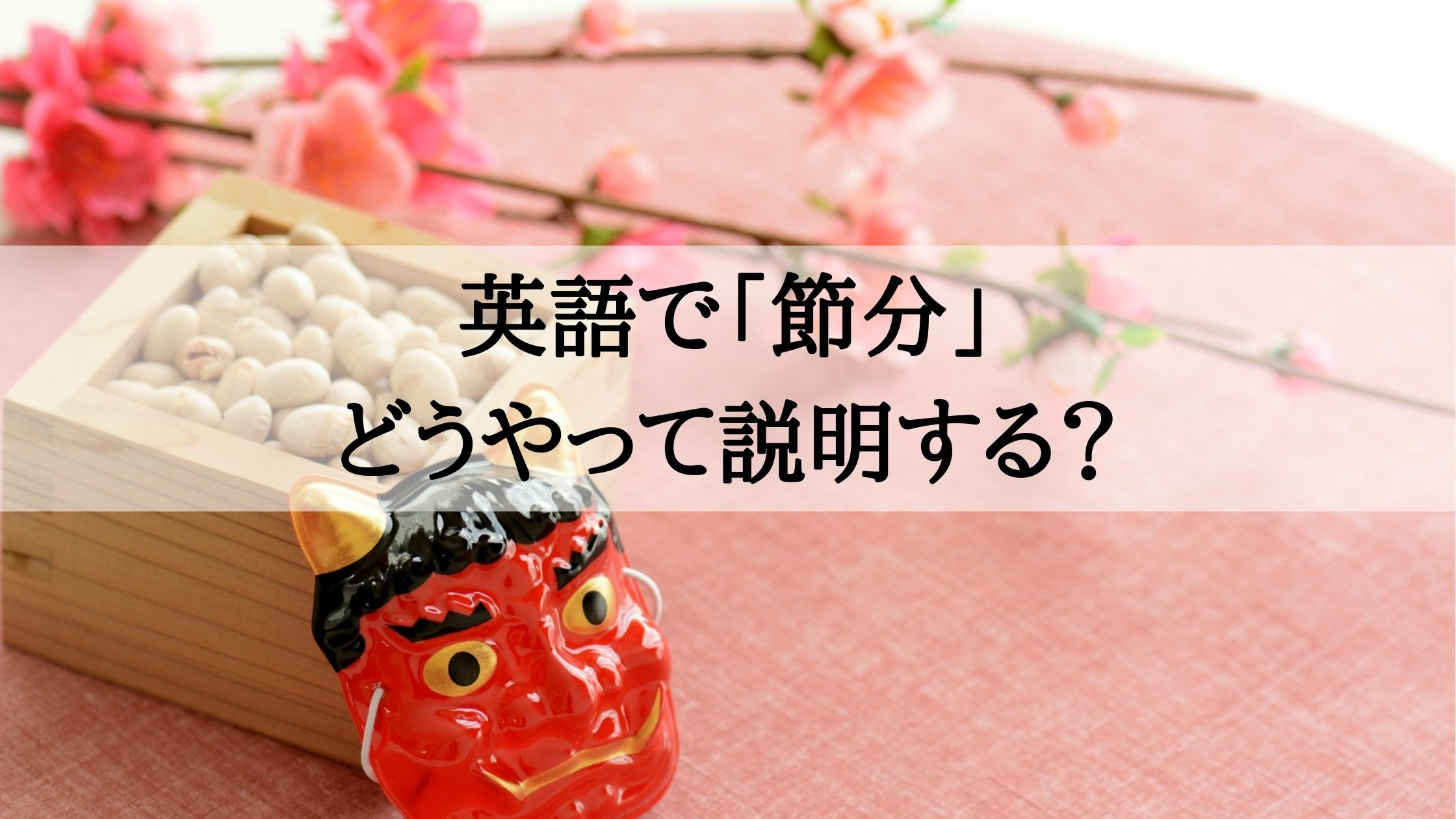2月の初めにやってくる節分。日本では多くの人にとって、幼いころから馴染みのある行事です。
起源は古く中国から伝わったとされますが、節分を祝う国は日本くらいで、海外にはない文化です。
そのまま「Setsubun」と言ってもなかなか伝わりません。
「鬼は外、福は内!」「恵方巻」「年の数だけ豆を食べる」などなど、英語では何というのでしょうか?早速、英語で「節分」を紹介してみましょう。
英語記事:

英語で「節分」は何と言う?
「節分」は日本の伝統行事のひとつです。豆を食べたり、投げたりして災害や不運、病気をもたらす厄を祓います。また、冬の終わりも意味します。自宅で祝われますが、お寺での有名なイベントを訪れても楽しいですよ。
Setsubun (節分) is a traditional Japanese event in Japan. Setsubun involves a lot of bean eating and bean throwing to ward off evil spirits that bring disaster, misfortune and bad health. It also marks the end of winter. It is celebrated at home but there are some famous public events at temples that are fun to visit as well.
節分とは、文字通り2つの季節(冬と春)の分け目です。日本でかつて使われていた旧暦の上では、節分は冬の終わり、立春といって、春の訪れを祝います。
2月はまだ冬だし、寒いじゃないかと思うかもしれませんが、立春が過ぎれば寒さは和らぐと言われています。
The word Setsubun (節分) literally means the division of two seasons: Winter and Spring. According to the lunar calendar that was once used in Japan, Setsubun refers to the end of winter, which also celebrates the arrival of spring, called Risshun (立春). It may sound confusing as February is still cold and still generally considered a part of winter, but it is said that after Risshun, the cold weather will get milder.
節分の歴史を英語で説明

一般的に、節分の起源は中国だと言われています。平安時代に日本に伝わり、室町時代には、災難を引き起こす邪気や厄を表す鬼を祓うために、豆を投げる習慣が始まりました。この習慣は今でも日本に根付いています。
日本の主食であった豆は、米と同じく厄を祓う霊力を宿すと信じられていました。
In general, it is believed that Setsubun has its origin in China. It was first introduced to Japan during the Heian Period (794-1185), and during the Muromachi Period(1336-1573), they started to throw beans to drive away demons that represent the evil spirits who bring all the disasters and tragic events. This remains one of the biggest parts of the event even today. As a staple food that was essential for them to survive, beans were believed to have sacred power along with rice, which could get rid of evil spirits.
英語で「豆まき」は何と言う?

英語で「豆まき」は、「throwing beans」と言います。
もう少し詳しく説明してみましょう。
豆まきは、炒った大豆を家中にまくことで、節分の日に一般的に行われる習慣です。
玄関から最も遠いところから、豆まきを始めるのが良いとされています。窓は開けたままにして、邪気が家から出るようにします。小さな子どもは、鬼の変装をした家族の一人に対して豆を投げます。
Mamemaki (豆まき), or throwing roasted soybeans around your house, is the most common custom that is exclusively carried out on Setsubun. It is said that it is best to start off with the room that is located the farthest from the entrance. Keep windows open as you throw the beans so that evil spirits can leave. Another custom, especially for small children, is throwing beans at a family member who is disguised as an oni demon.
「鬼は外、福は内!」は英語で何と言う?

「鬼は外、福は内!」は英語で「Demons out, fortune in!」と訳せます。
家中に豆をまいたり、鬼に豆を投げるとき、「鬼は外、福は内!」と言います。
We usually say “Oni wa Soto, Fuku wa Uchi!” (鬼は外、福は内!) as we scatter beans around the house or throw them at the demons. It means “Demons out, fortune in!” in English.
「年の数だけ豆を食べる」は英語で何と言う?
多くの人は、年の数だけ豆を食べ、これは健康をもたらすと言われています。
Many people eat the same number of roasted beans as their age, and this is said to bring good health.
「恵方巻」は英語で何と言う?

「恵方巻」は「Fortune Sushi Roll」と訳せますが、どんなものか説明をしなければ伝わりません。「Sushi」は世界でも通じる日本語ですので、少し丁寧に説明してみましょう。
恵方巻は節分の日に食べられるユニークな巻き寿司です。寿司レストランなどで見る普通の巻き寿司よりも、長くて大きいものです。一般的に、7という数字が幸運を表すため、マグロや卵など7つの具材を使うと良いとされています。7名の七福神という神様がいることに由来してるんですよ!
Ehomaki is a unique type of sushi roll that is generally eaten only on Setsubun. It’s relatively long and big compared to the ordinary Sushi rolls that you can find at sushi restaurants. In general, it is considered good to use seven ingredients such as tuna and egg for Ehomaki as the number is often associated with “Lucky”. It also comes from the fact that we have 7 famous gods of fortune called Shichifukujin (七福神) in Japan!
恵方巻を食べるとき、福を呼ぶと言われる方角を向いて食べます。この方角は毎年変わりますが、2022年は北北西です。恵方巻を食べる間、目をつむってお願いごとをしてください。1巻を一気に止まらずに食べるんです!
When you eat Ehomaki, you need to face the direction that is believed to bring you good fortune during the year. The direction changes every year and it’s north-northwest in 2022.
It is also important to make a wish with your eyes closed while eating Ehomaki. People eat the entire roll at one time without stopping (or giving up)!
英語で説明しようシリーズ
「節分」を英語で説明してみよう、いかがでしたか?
そのほかの「英語で説明してみよう」シリーズもぜひ覗いてみてください。
英語で日本の文化や行事を説明する機会に、お役に立てたら嬉しいです。








コメント